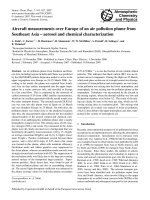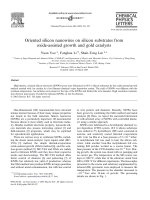Nutritional cosmetics beauty from within (personal care and cosmetic technology)
Bạn đang xem bản rút gọn của tài liệu. Xem và tải ngay bản đầy đủ của tài liệu tại đây (30.67 MB, 544 trang )
PERSONAL CARE AND COSMETIC
TECHNOLOGY
Series Editor: Meyer Rosen
President, Interative Consulting, Inc., NY, USA
9780815515043 Delivery System Handbook for Personal Care and
Cosmetic Products: Technology, Applications and Formulations (2005)
Edited by Meyer Rosen
9780815515678 Global Regulatory Issues for the Cosmetics Industry,
volume 1 (2007) Edited by C. I. Betton
9780815515692 Global Regulatory Issues for the Cosmetics Industry,
volume 2 (2009) Edited by Karl Lintner
9780815515722 Cosmetic Applications of Laser and Light-Based
Systems (2009) Edited by Gurpreet S. Ahluwalia
9780815515845 Skin Aging Handbook: An Integrated Approach to
Biochemistry and Product Development (2008) Edited by
Nava Dayan
9780815520290 Nutritional Cosmetics: Beauty from Within (2009)
Edited by Aaron Tabor and Robert M. Blair
William Andrew is an imprint of Elsevier
Linacre House, Jordan Hill, Oxford OX2 8DP, UK
30 Corporate Drive, Suite 400, Burlington, MA 01803, USA
First edition 2009
Copyright © 2009 Elsevier Inc. All rights reserved
No part of this publication may be reproduced, stored in a retrieval system or transmitted
in any form or by any means electronic, mechanical, photocopying, recording or otherwise
without the prior written permission of the publisher
Permissions may be sought directly from Elsevier's Science & Technology Rights
Department in Oxford, UK: phone (+44) (0) 1865 843830; fax (+44) (0) 1865 853333;
email: Alternatively visit the Science and Technology
website at www.elsevierdirect.comJrights for further information
Notice
No responsibility is assumed by the publisher for any injury and/or damage to persons
or property as a matter of products liability, negligence or otherwise, or from any use or
operation of any methods, products, instructions or ideas contained in the material herein.
Because of rapid advances in the medical sciences, in particular, independent verification
of diagnoses and drug dosages should be made
British Library Cataloguing in Publication Data
A catalogue record for this book is available from the British Library
Library of Congress Cataloging-in-Publication Data
A catalog record for this book is available from the Library of Congress
ISBN: 978-0-8155-2029-0
For information on all William Andrew publications
visit our website at elsevierdirect.com
Printed and bound in United States of America
09 10 II 12 II 10 9 8 7 6 5 4 3 2 I
Working together to grow
libraries in developing countries
www.elsevier.com I www.bookaid.org I www.sabre.org
We dedicate this book to everyone who believes beauty is more than
skin deep.
Contributors
Farrukh Afaq, PhD
Associate Scientist
Department of Dermatology
University of Wisconsin
4385 Medical Sciences Center
1300 University Avenue
Madison, WI 53706
Phone: + 1 608 263 5519
Email:
Rajesh Agarwal, PhD
Professor
UCD School of Pharmacy
4200 East 9th Avenue, C-238
Denver, CO 80262
Phone: +13033151381
Fax: +1 303 315 6281
Email:
Christian Artaria, BSc
Indena S.p.A.
Viale Ortles, 12
20139 Milan
Italy
Yutaka Ashida, PhD
Shiseido Co., Ltd.
Frontier Science Labs
2-12-1 Fukuura Kanazawa-Ku
Yokohama 236-8643
Japan
Email: yutaka.ashidawto.shiseido.co.jp
Debasis Bagchi, PhD, FACN, CNS
Department of Pharmacological & Pharmaceutical Sciences
College of Pharmacy
University of Houston
Houston, TX
Email:
xi
xu
CONTRIBUTORS
Manashi Bagchi, PhD, FACN
Interhealth Research Center
Benicia, CA
Email:
JaIil Benyacoub, PhD
Nestle Research Center
Vers-Chez- Les-Blanes
P.O. Box 44
1000 Lausanne 26
Switzerland
Bruno Berra, PhD
Professor
Institute of General Physiology and Biochemistry, "G. Esposito"
Via Trentacoste 2
20134 Milan
Italy
Phone: +390250315777
Fax: +390250315775
Email:
Robert M. Blair, PhD
Physicians Pharmaceuticals, Inc.
1031 E. Mountain Street, Building 302
Kernersville, NC 27284
Phone: + 1 336 722 2337 Ext. 1734
Fax: +1 3367227712
Email:
Stephanie Blum, PhD
Nestle Research Center
Vers-Chez-Les-Blanes
P.O. Box 44
1000 Lausanne 26
Switzerland
CONTRIBUTORS
Lionel Breton, PhD, DrSc
L'Oreal
Charles Zviak Center
90 Rue du General Roguet
92 583 Clichy Cedex
France
Phone: +33 147567887
Fax: +33 I 47 564007
Petra Caessens, PhD
DMV International
40196 State Highway 10
Delhi, NY 13753
Isabelle Castiel, PharmD, PhD
Scientific Coordinator Food Supplement Research
Life Science Research
L' Oreal Research and Development
L'Oreal
Centre C. Zviak
90 Rue du General Roguet
92 583 Clichy Cedex
France
Phone: +33493830965
Fax: +33 I 47 56 40 07
Email:
Dr. Leonardo Celleno
Department of Dermatology
Catholic University of Sacred Heart
Largo A. Gemelli 8
00168 Rome
Italy
Phone: +39063503591
Fax: +39063503547
Email:
Meera Chandramouli
PL Thomas & Co., Inc., NJ, USA
Phone: + I 973 984 0900 Ext. 215
Email:
Xlll
XIV
Aldo Cristoni, PhD
Indena S.p.A.
Viale Ortles, 12
20139 Milan
Italy
Email:
Gagan Deep, PhD
Research Associate
UCD School of Pharmacy
4200 East 9th Avenue, C-238
Denver, CO 80262
Phone: +1303315 1228
Fax: +1 3033156281
Email:
Rick de Waard, PhD
R&D Director, Nutritionals
DMV International
Innovium
Nieuwe Kanaal 7r
NL-6709 PA Wageningen
The Netherlands
Phone: +31 0610377844
Dushka Dimitriejvic, MSc
Vitiva d.o.o.
Nova vas pri Markovcih 98
2281 Markovci
Slovenia
Phone: +3862 788 87 38
Fax: +38627888745
Email:
David Djerassi
President
Intrachem Technologies
NewYork,NY
Email:
CONTRIBUTORS
CONTRIBUTORS
Zoe Diana Draelos, MD
Dermatology Consulting Services, Inc.
2444 N. Main Street
High Point, NC 27262-7833
Email:
Craig A. Elmets, MD
Department of Dermatology
University of Alabama at Birmingham
Birmingham, AL 35294
Andrea Giori, PhD
Indena S.p.A.
Viale Ortles, 12
20139 Milan
Italy
Email:
Audrey Gueniche, PharmD, PhD
Project Director
Oral Route Research-Skin and Hair
L'Oreal
Charles Zviak Center
90 Rue du General Roguet
92 583 Clichy Cedex
France
Phone: +33 1 47 5640 15 or +33660992467
Fax: +33 1 47 56 78 88
Email:
Rebat M. Halder, MD
Professor and Chairman
Department of Dermatology
Howard University College of Medicine
2041 Georgia Avenue, N.W.
Washington, DC 20060
Phone: + 1 202 865 6725
Fax: +1202865 1757
Email:
xv
xvi
Takeshi Ikemoto, PhD
Kanebo Cosmetics
Basic Research Laboratory
3-28, 5-Chome, Kotobuki-Cho, Odawara-Shi
Kanagawa-Ken, 250-0002, Japan
Eunsun Jung
Biospectrum Life Science Institute
SK Ventium 101-701
#552 Dangjung Dong
Gunpo City
Gyunggi Do, 435-776
Republic of Korea
Phone: +82 31 436 2090
Fax: +82 31 436 0605
Santosh K. Katiyar, PhD
Associate Professor of Dermatology
Department of Dermatology
1670 University Boulevard
Volker Hall 557, Box 202
University of Alabama at Birmingham
Birmingham, AL 35294
Phone: + I 205975 2608
Fax: + I 205 9345745
Email:
Suchitra Katiyar, BS, MPH
Department of Dermatology
University of Alabama at Birmingham
Birmingham, AL 35294
Manjinder Kaur, PhD
Research Associate
UCD School of Pharmacy
4200 East 9th Avenue, C-238
Denver, CO 80262
Phone: +1 3033152187
Fax: +1 3033156281
Email:
CONTRIBUTORS
CONTRIBUTORS
Saebom Kim, PhD
Biospectrum Life Science Institute
SK Ventium 101-701
#552 Dangjung Dong
Gunpo City
Gyunggi Do, 435-776
Republic of Korea
Phone: +82 31 436 2090
Fax: +82 31 4360605
Su Na Kim
Natural Products Research Institute
College of Pharmacy
Seoul National University
28 Yeonkun-Dong, Jongno-Ku
Seoul 110-460
Korea
Yeong Shik Kim, PhD
Professor
Natural Products Research Institute
College of Pharmacy
Seoul National University
28 Yeonkun-Dong, Jongno-Ku
Seoul 110-460
Korea
Phone: +82 2 740 8929
Fax: +82 2 765 4768
Email:
Chesahna Kindred, MD, MBA
Department of Dermatology
Howard University College of Medicine
2041 Georgia Avenue, N.W.
Washington, DC 20060
xvii
xviii
Majda Hadolin Kolar, PhD
Vitiva d.d.
Nova vas 98
2281 Markovci
Slovenia
Phone: +38627888736
Fax: +386 2 7888 745
Email:
Dr. Jean Krutmann, MD
Professor of Dermatology & Environmental Medicine
Director
Institut fur Umweltmedizinische Forschung (lUF)
at the Heinrich-Heine-University DUsseldorf gGmbH
Auf'm Hennekamp 50
D-40225 DUsseldorf
Germany
Phone: +49 211 3389224
Fax: +49 211 3389 226
Email:
Francis C. Lau, PhD, FACN
Interhealth Research Center
Benicia, CA
Email:
Jongsung Lee
Natural Products Research Institute
College of Pharmacy
Seoul National University
28 Yeonkun-Dong, Jongno-Ku
Seoul 110-460
Korea
Juhyeon Lee
Natural Products Research Institute
College of Pharmacy
Seoul National University
28 Yeonkun-Dong, Jongno-Ku
Seoul 110-460
Korea
CONTRIBUTORS
CONTRIBUTORS
Howard I. Maibach, MD
Department of Dermatology
University of California
90 Medical Center Way
Surge 110, Box 0989
San Francisco, CA 94143-0989
Phone: + I 949 533 6892
Fax: +1 415 753 5304
E-mail:
Giada Maramaldi, BSc
Indena S.p.A.
Viale Ortles, 12
20139 Milan
Italy
Email:
Pierfrancesco Morganti, PhD
R&D Directdor
Mavi Sud. S.r.l.
Via dell' Industria I
040 II Aprilia (LT)
Italy
Email:
Hasan Mukhtar, PhD
Helfaer Professor of Cancer Research
Director and Vice Chair of Research
Department of Dermatology
University of Wisconsin
4385 Medical Sciences Center
1300 University Avenue
Madison, WI 53706
Phone: + I 608 263 3927
Email:
Ayako Noguchi, MSc
Kyowa Hakko U.S.A., Inc.
767 Third Avenue, 19th Floor
New York, NY 10017
Phone: +1212.319.5353
Email:
xix
xx
Christian O. Oresajo, PhD
Department of Dermatology
Howard University College of Medicine
2041 Georgia Avenue, N.W.
Washington, DC 20060
Deokhoon Park, PhD
Biospectrum Life Science Institute
SK Ventium 101-701
#552 Dangjung Dong
Gunpo City
Gyunggi Do, 435-776
Republic of Korea
Phone: +82 31 436 2090
Fax: +82 31 4360605
Nadine Pomarede, MD
Isocell, Paris, France
and
PL Thomas & Co., Inc., NJ, USA
Phone: +1 973 984 0900 Ext. 215
Email:
Myriam Richelle, PhD
Nestle Research Center
Nestec Ltd
P.O. Box 44
CH-1000
Lausanne 26
Switzerland
Phone: +41 21 785 8407
Fax: +41 21 7858544
Email:
CONTRIBUTORS
CONTRIBUTORS
Angela Maria Rizzo, PhD
Professor
Institute of General Physiology and Biochemistry, "G. Esposito"
Via Trentacoste 2
20134 Milan
Italy
Phone: +390250315789
Fax: +390250315775
Email: angelamaria.rizzo@unimLit
Hiroshi Shimoda, PhD
Oryza Oil & Fat Chemical Co., Ltd.
I Numata, Kitagata-cho
Ichinomiya-city, Aichi
493-800 I , Japan
Phone: +81 586865141
Fax: +81 586866191
Email:
Heike Steiling, PhD
Nestle Research Center
Nestec Ltd
P.O. Box 44
CH-lOOO
Lausanne 26
Switzerland
Deeba N. Syed, MBBS
Research Specialist
Department of Dermatology
University of Wisconsin
4385 Medical Sciences Center
1300 University Avenue
Madison, WI 53706
Phone: + I 608 263 5519
Email:
xxi
XXll
Aaron Tabor, MD
Physicians Pharmaceuticals, Inc.
1031 E. Mountain Street, Building 302
Kernersville, NC 27284
Phone: + 1 336 722 2337
Fax: + 1 3367227712
Email:
Dr. Federica Tamburi
Department of Dermatology
Catholic University of Sacred Heart
Largo A. Gemelli 8
00168 Rome
Italy
Phone: +39 06 3503591
Fax: +39063503547
Simona Urbaneic
Vitiva d.d.
Nova vas 98
2281 Markovci
Slovenia
Phone: +386 2 7888 736
Fax: +38627888745
Email:
James Varani, PhD
Department of Pathology
The University of Michigan
1301 Catherine RoadIBox 0602
Ann Arbor, MI 48109
Phone: + 1 734 615 0298
Fax: + 1 734763 6476
Email:
Jeanette Waller, MD
Department of Dermatology
University of California
90 Medical Center Way
Surge 110, Box 0989
San Francisco, CA 94143-0989
Email:
CONTRIBUTORS
CONTRIBUTORS
Angela Walter
Market Development Manager
DMV International
40196 State Highway 10
Delhi, NY 13753
Phone: +1 6077460206
Email:
Wendeline Wouters, PhD
Nutrition Science & Technical Sales Support Manager
DMV International
40196 State Highway 10
Delhi, NY 13753
Phone: +16077460126
Fax: +16077460183
Email:
Shirley Zafra-Stone, BS
Interhealth Research Center
Benicia, CA
Email:
Danny Zaghi
1299 Bedford Ct.
Sunnyvale, CA 94087
Email:
Mohammad Abu Zaid, PhD
Assistant Researcher
Department of Dermatology
University of Wisconsin
4385 Medical Sciences Center
1300 University Avenue
Madison, WI 53706
Phone: + 1 608 263 5519
Email:
XXlll
Foreword
We will all live decades longer than our grandparents and parents and will
have better health in our later years. With this enhanced longevity, we all
want to look as young as we feel. Especially because we are inundated
with images of youthful beauty on television, in films, and in glossy
fashion magazines, we feel social pressure to improve our appearance.
Aspiring to maintain "eternal youth" and to look good is not new and is not
just superficial "vanity." Our human nature dictates that we take care of
ourselves and enhance our appearance. Throughout history, women from
Cleopatra to Marie Antoinette to today's movie stars have used cosmetics
and nutrients to beautify and rejuvenate. Indeed recent psychological studies
have proven that the better we look, the better we feel, and the healthier,
happier, and more productive we become.
Today in the United States the number of over-45-year-olds is growing
at three times the rate of the general population. To meet this demand, the
cosmetic, nutrition, and health care industries have created an enormous
variety of anti-aging nutritional products, supplements, topical treatments,
and medical and cosmetic procedures.. Information and misinformation
abound. Sales representatives and retail clerks, popular press editorials
and advertisements, television commercials and infomercials, news and
beauty segments, home shopping networks, and the internet-all present
nutritional supplements and skin care products promising beautification
with reversal of the appearance of aging. How can we navigate our way
through this labyrinth of claims and counterclaims?
Over 25 years ago, the prominent dermatologist Dr. Albert Kligman
defined the category "cosmeceuticals" to describe topical formulations
that improve the appearance of the skin by actually altering the function
of the skin in a scientifically measurable way. More recently the terms
"nutricosmetics" or "nutraceuticals" have defined foods and dietary supplements that benefit the health and beauty of the skin by directly affecting
mechanisms and metabolism. Such cosmeceuticals and nutricosmetics are
not subject to the stringent criteria and costly studies required for "drugs"
in order to provide scientific and medical proof of safety and efficacy for
approval by the U.S. Food and Drug Administration. Therefore, while
savvy marketers promote products based loosely on science, consumers
and even physicians cannot truly judge the merits of most claims.
This text, Nutritional Cosmetics: Beauty from Within, edited by
Aaron Tabor, MD, and Robert M. Blair, PhD, presents for the first time
xxv
XXVi
FOREWORD
a compendium of the science behind dietary ingredients with the potential
to benefit the health and therefore the appearance of the skin. The authors
are medical doctors and scientists from academia and industry who recognize that careful, controlled studies are required to demonstrate efficacy of
specific ingredients in humans, even after mechanisms of action are demonstrated in in vitro and in animal models. Furthermore, substantiation of
each specific formulation of each product applied topically or taken orally
is of utmost importance. The molecular form and the purity of the active
component, the concentration, the vehicle, the pH, and the coating all
affect the absorption and activity and therefore the efficacy.
This text opens with chapters describing in detail the structure and the
physiology of the skin as well as the ethnic variations in certain properties
and disorders of the skin and differences in cultural practices. In the following chapters, we realize that, amazingly, even several decades ago, we
did not understand that environmental pollutants affect the skin, particularly sun exposure and smoking. These chapters summarize current
research on mechanisms and consequences of these external onslaughts,
particularly describing recent discoveries regarding the distinction between
intrinsic, natural aging and extrinsic, premature aging, elucidating distinct
clinical manifestations and mechanisms of each. With this review of skin
physiology, how nutricosmetic ingredients can be studied to prove efficacy
can be understood.
The rest of this book compiles evidence and verification as previously
published in the scientific and medical literature as well as internal studies
by industry about dietary ingredients with potential for skin healthincluding those already being applied topically. With this documentation,
the reader will recognize that there are indeed nutritional supplements that
have scientific substantiation of preventing and reversing aging, of protecting, of moisturizing, and of treating specific problems of the skin.
The most comprehensively researched nutricosmetics are antioxidants
(vitamins C and E, carotenoids, coenzyme QlO, as well as botanicals such
as the polyphenols [catechins] in green tea, the tannins and ftavanoids in
pomegranate, resveratrol in grapes, anthocyanins in berries, silibinin in
milk thistle, carnosic and rosmarinic acids in rosemary, and genistein in
soy), as well as antioxidant enzymes and trace mineral cofactors for these
enzymes (such as selenium and zinc). Studies on each of these are
excellently and comprehensively reviewed.
Certain nutricosmetics affect epidermal moisturization and barrier
function and/or the extracellular matrix. Some ingredients can increase
synthesis of collagen and prevent the UV-induced degradation of collagen
and elastic tissue by matrix metalloproteinases; others increase fibroblast
FOREWORD
XXVII
proliferation and cell turnover and may even induce signaling for cellular
differentiation or apoptosis. A review of evidence that amino acids,
ceramides, and other plant extracts can influence epidermal moisturization
and dermal mechanisms is presented.
One important chapter summarizes the benefits to the skin of probiotics
(living microorganisms), which influence the composition ancl/or metabolism of the endogenous gut and skin microbiota. By modulating immune
function, probiotics are prophylactic and therapeutic for atopic dermatitis,
skin sensitivity, and food allergies. Lactobacillus johnsonii protects Langerhans cells from depletion after UV radiation, whereas Lactobacillus pesodoris inhibits odor-producing bacteria of the gut and armpits.
Numerous epidemiological studies link the abundance of particular
nutrients with disease prevention and improved health. Armed with these
correlations, doctors and scientists have incorporated certain of these
nutrients into topical and oral formulations to improve the health and
appearance of the skin. This text comprehensively reviews research on
nutrients for which there is evidence of benefit to the skin "from within."
Future skin care will undoubtedly focus on these cosmeceuticals and
nutraceuticals. In confirming that we can indeed achieve "beauty through
science," this book is a springboard to stimulate new ideas and future
research.
Karen E. Burke, MD, PhD
Department of Dermatology
Mount Sinai Medical Center
New York, NY, USA
Preface
Nutritional cosmetics, more commonly referred to as nutricosmetics,
embraces the idea that beauty can be enhanced through the consumption
of functional dietary products that may support healthier and thus more
beautiful skin. The term nutricosmetics appears to borrow from the terms
nutraceuticals and cosmeceuticals to reflect the goal of these products, that
is, to provide health and beauty benefits to the skin via nutritional products
consumed on a regular basis.
The idea that food or other dietary ingredients can support healthy skin
and beauty has existed for ages. Some of the earliest dietary products marketed for skin health and beauty included Merz Spezial-Dragees in 1964
and Oenobiol's Solaire in 1989. Despite these early forays into the nutrition and beauty arena, the market for nutricosmetic products has only
recently begun to take off with any real force. A recent market research
report by Kline & Company indicates that the global nutricosmetic market
is valued at $1.5 billion with the vast majority of that due to the markets in
Japan and Europe. According to Euromonitor International, the market for
nutricosmetics was $2.1 billion, which was only 3% of the overall skincare
market, suggesting that nutriticosmetics is still very much an emerging
market. In fact, various market analyses suggest that the market for nutricosmetic products will continue to increase at a substantial rate.
At the moment it appears that the marketing of nutricosmetics is ahead
of the science for these products and ingredients in general, though that is
not to say that quality research has not been done on some nutricosmetic
ingredients. To date, there are a multitude of ingredients now being marketed for their purported skin health and beauty benefits and their utility
for incorporation into nutricosmetic products. These ingredients often are
marketed based on their antioxidant capacity and the resulting inferred
skin benefits. However, in many cases no research on their actual dermatological benefits has been published or conducted. Nonetheless, many of
these ingredients are already being applied topically with positive results,
so it would not be totally surprising if oral consumption produced similar
effects.
A look into the peer-reviewed scientific literature reveals an emerging
body of evidence in support of the potential benefits of nutritional products
for skin health. The studies are wide ranging and explore the effects of
ingredients on both mechanistic endpoints (antioxidant capacity, antiinflammatory properties, modulation of enzymes involved in extracellular
xxix
xxx
PREFACE
matrix restructuring, etc.) and functional endpoints (anti-wrinkling, reduction
of erythema, skin hydration, etc.). While the science in this area is quickly
emerging, it is far from extensive enough to provide definitive conclusions
at this time. In addition to the growing body of evidence published in the
scientific literature, a plethora of information has been presented only in
industry white papers or marketing materials. These materials show the
promise of many of the marketed ingredients and also provide a great starting
point for more definitive studies.
The purpose of this book was to compile the scientific evidence showing the potential benefits of at least some of the better-studied nutricosmetic ingredients. We started this project by searching the peer-reviewed
literature for nutritional ingredients with evidence of skin health benefits.
We additionally contacted several industry leaders currently marketing
nutricosmetic products backed by scientific research. The response from
the thought leaders in this field was overwhelming and the result is this
compilation of excellent contributions that delve into the science behind
dietary ingredients for improved skin health.
It is apparent that consumers today are very well informed and take
their personal care very seriously. More and more consumers are looking
for products that are both environmentally friendly and provide specific
health benefits that meet their specific needs. With this interest in the
potential health benefits of the products they consume, the importance of
the science behind the products will continue to grow. While many functional ingredients will initially do well in the market based on their novelty, we believe that ingredients and products with sound science behind
them will lead the way in the field of nutricosmetics.
Aaron T. Tabor, MD, and Robert M. Blair, PhD
June 2009
Introduction
Aaron Tabor, MD, and Robert M. Blair, PhD
Physicians Pharmaceuticals tnc., Kernersville, NC, USA
1.1 What is "Nutritional Cosmetics"?
Nutritional cosmetics, which is probably better known in the industry as
nutricosmetics, encompasses the concept that orally ingestible dietary
products may support healthier and thus more beautiful skin. This is not
totally unlike the term nutraceutical; however, this latter term typically
refers to foods and dietary supplements that support better overall health.
Similarly, the term cosmeceutical refers to products generally designed for
topical application and which contain active ingredients with benefits for
improved skin health.
The term nutricosmetics appears to borrow from the terms nutraceuticals
and cosmeceuticals to reflect the goal of these products, that is to provide
beauty and health benefits to the skin via nutritional products consumed on
a regular basis. This concept encompasses a unique amalgamation of the
nutrition and personal care industries.
More and more nutricosmetic products are reaching the retail shelves
and can be found as functional beverages (e.g., NutriSoda from Andrea
Beverage Co., Skin Balance Water from Borba), dietary supplements (e.g.,
Murad's Firm & Tone dietary supplement, Perricone's Skin & Total Body
dietary supplement), and functional foods (e.g., Danone's Essensis beauty
yogurt, Ecco Bella's Chocolate Instant Bliss Beauty Bar).
xxxi
XXXll
INTRODUCTION
1.2 The Nutricosmetic Market
While the idea that dietary ingredients can support healthy skin and beauty
has been around for some time, it seems that it is only now receiving much
attention. As such, the market for nutricosmetic products has only recently
begun to take off with any real force. According to the 2006 Datamonitor
report "Seeking Beauty Through Nutrition" (from Seaton T. Wellness trends
in personal care. Beauty from the Inside & Out 2006; 1:16-22), sales of
oral beauty supplements in 2005 was $742 million in the United States,
$224 million in France, $162 million in Germany, and $95 million in the
United Kingdom. Expected growth of oral beauty supplement sales through
the year 2010 ranges from approximately 7% to 12%.
According to this article, the Datamonitor report further indicated that
half of the survey participants considered themselves conscious of skin
nutrition, while nearly half of the respondents believed that what they ate
could have just as much effect on skin health as topical products. With this
belief and consumers' ever-growing interest in the science behind the
products they choose, we believe that ingredients and products with sound
science behind them will lead the way in the field of nutricosmetics.
1.3 "Nutritional Cosmetics: Beauty from
Within"-An Overview
There are a multitude of ingredients now being marketed for their
purported skin health and beauty benefits and their utility for incorporation
into nutricosmetic products. These ingredients often are marketed based
on their antioxidant capacity and inferred skin benefits, though little or no
research on their dermatological benefits has been published. However,
many of these ingredients are already being applied topically with a reduction in wrinkles, so it is not that much of a surprise that oral consumption
may produce similar effects.
Nonetheless, there are quite a few dietary ingredients with scientific
backing for their potential skin health benefits. Though some of this
evidence has been published in the scientific literature, a plethora of information has been presented only in industry white papers or marketing
materials. The purpose of this book is to compile the scientific evidence
showing the potential benefits of at least some of these nutricosmetic
ingredients. By including the efforts of both academic and industry investigators, we believe that the presentation of the known scientific data with
new information brings the state of nutricosmetic science up to the present
INTRODUCTION
XXXlll
and provides a foundation from which to generate new ideas and information. Where possible, information specifically about the benefits of ingredients consumed orally for skin health is presented.
Part I of this book consists of four chapters that provide an excellent
overview of skin biology, including an in-depth look at the structure and
function of skin and its components by Dr. Leonardo Celleno, an examination of ethnic skin by Dr. Chesahna Kindred, and overviews of both natural
(Mr. Danny Zaghi) and premature (Dr. Jean Krutmann) aging of the skin.
In Chapter 5, Dr. Pierfrancesco Morganti discusses the concept of "beauty
from within" and the integration of functional foods with cosmeceuticals for
total body beauty from the inside and the outside. Vitamins and minerals
have been reported to have healthful benefits for the skin. These are explored
in Chapters 6 (Dr. Myriam Richelle) and 7 (Dr. Bruno Berra).
One of the most popular categories of nutricosmetic ingredients is the
antioxidants. These ingredients have been proposed to support skin health
and beauty through their ability to suppress and/or reverse oxidative damage to the skin caused by such stressors as UV light from the sun. Some of
the more popular and efficacious ingredients are examined in Part 4 of the
book, which starts off with an excellent overview of the potential benefits
of botanical antioxidants by Dr. Mohammad Abu Zaid. which briefly
touches upon the role of several specific ingredients. This part of the
book also includes chapters on carotenoids (Dr. Pierfrancesco Morganti),
coenzyme Q 10 (Dr. Yutaka Ashida), healthy fruits (Dr. Francis Lau), olive
fruit (Dr. Aldo Cristoni), and the skin's natural antioxidant enzymes
(Dr. Nadine Pomarede).
One of the more important aspects of healthy looking skin is a smooth
appearance. However, a smooth appearance can be difficult to maintain
without a firm foundation and proper hydration. Dr. James Varani and Dr.
Zoe Oraelos discuss the importance of these aspects. Natural dietary ingredients that may support a firm skin foundation and proper skin hydration are
discussed in Parts 5 and 6 of the book. A firm, skin-supporting foundation
may be boosted with ingredients that are precursors to the skin's extracellular matrix like amino acids. Additionally, ingredients that stimulate collagen synthesis and inhibit enzymes responsible for the breakdown of the
extracellular matrix may support the skin's foundation. Proper hydration is
important for both the skin's barrier function and for a smooth appearance.
Such ingredients as rice ceramides and tocotrienols are discussed in this
regard. Additionally, ingredients that support fibroblast proliferation and cell
turnover may lead to smoother, healthier-looking skin.
In addition to dietary ingredients that may help support a firm foundation and good skin hydration. a number of other ingredients have been









